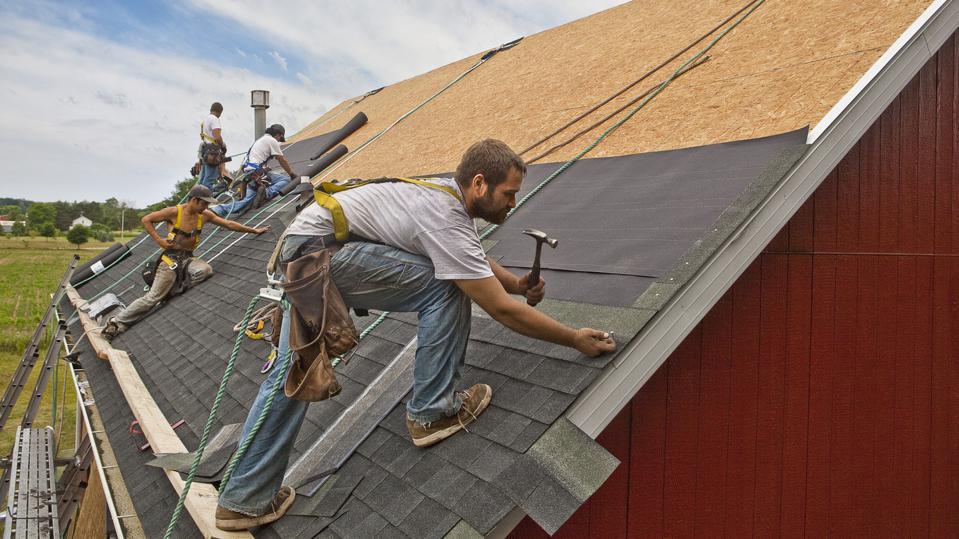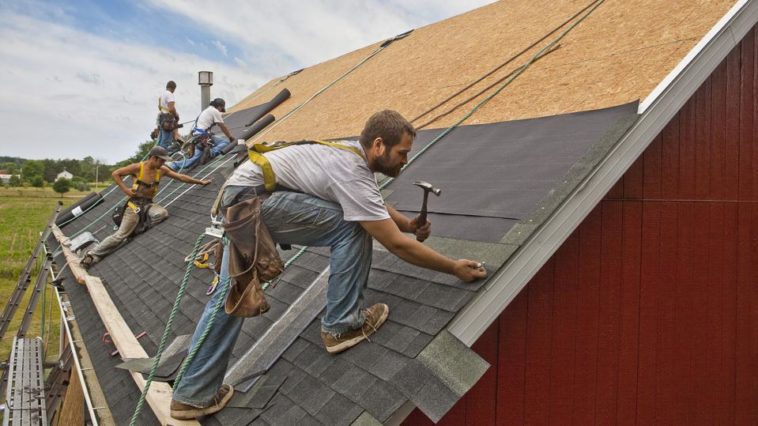How Much Does A Roof Replacement Cost?

Editorial Note: Forbes Advisor may earn a commission on sales made from partner links on this page, but that doesn’t affect our editors’ opinions or evaluations.
Compare Quotes From Top-rated Local Roofers
Free, No-commitment Estimates
There’s no feeling more comforting than having a roof over your head, and it’s something that the majority of us take for granted. Just the same, a roof doesn’t last forever. So what does a roof replacement cost? When things go wrong with your roof, it’s crucial to handle the issue right away.
Unaddressed cracks or leaks in a roof can lead to water damage and rotting underneath the shingles and can eventually cause the ceiling on your home to collapse. This can lead to extensive damage inside your home, including loss of valuable possessions and can even cause a dangerous situation for your family.
Have you been putting off a much-needed roof repair or replacement? You’ve come to the right place. Here, we’ll provide you with all the information you need if you’re wondering about the cost to replace a roof, along with a breakdown of different roofing materials, and how to decide whether to repair or replace your roof.
How Much Does a Roof Replacement Cost?
Replacing a roof is without a doubt one of the larger expenses you’ll face as a homeowner. What’s worse, it’s not a home improvement that you can directly enjoy once it’s finished, like, say, a new deck or a renovated kitchen. But it’s an investment in your property that will keep your home in good shape for years to come.
The average lifespan of a newly replaced roof is 30 to 100 years, depending on the type of roofing material that you choose. And if you need more good news, you’ll recoup some of the average cost to tear off and replace a roof when you go to sell your home.
Zillow estimates that a roof replacement will return somewhere around 60% of its value in a real estate transaction. Keren Jayne, a realtor with Pearson Smith, says, “A new roof is marketable [investment] which pays off in other ways. The more marketable features your home has, the more potential buyers and competitive offers it will attract.”
The national average cost to replace a roof is around $8,000, with most people spending in the range of $5,500 to $11,000. The two largest variables you’ll deal with on a job like this are the square footage of your home (and thus, your roof), and the type of roofing material you choose.
Roof Replacement Estimate
Roofing Cost Per Square Foot
When you receive a roof replacement estimate from a roofing professional, you can expect about 60% of that estimate to be for the roofing labor cost per square foot, and about 40% of it to cover the materials needed for your roofing job. Below, we’ll go into more detail on both costs, and what you can expect as far as variability in your price quote.
Labor
The average roofing labor cost is between $1.50 and $3.00 per square foot. In roofing, there’s a common term called a “square” that you need to know. One roofing square covers 100 square feet. So you may receive a labor quote of $150 to $300 per square. That’s the same thing as a quote like the one above, $1.50 to $3.00 per square foot. It’s good to understand this distinction so that you’re not confused when you receive your quote.
Some factors that can cause an increase or decrease in your roofing labor quote include the following:
- Extent of the damage:
Extensive rotting of timbers underneath the shingles not only makes the job more difficult, it makes it much more dangerous, too. So your roofing professional may increase or even double the cost to replace your roof if you’ve got rotting wood under your roof, since they’ll need more time and equipment to ensure their own safety while completing your roofing replacement.
- Environmental conditions:
Harsh conditions like extreme cold or heat can both increase the rate you’ll pay for the job, especially if it means your roofing professional has to bring in protective elements for the team.
- Removal of old material:
In some cases, a roof that needed to be replaced years ago may have instead been reshingled in the hopes of “buying time” on the repair. If your home is one of them, you may have more than one layer of shingles that need to be removed in order to repair or replace the roof. This, of course, will be reflected in the roofing labor cost per square foot.
Materials
The average material costs for roofing typically accounts for about 40% of your roof replacement cost, and this could cost anywhere from $100 to $1,000 per square (again keeping in mind that a square is 100 square feet). But that can vary dramatically depending on what type of roof you’re having installed. The further you stray from typical asphalt shingles, the more you’ll pay for roofing materials.
Below, we’ll break down the cost to replace a roof based on some of today’s most popular roofing materials.
Roofing Costs by Type
Asphalt shingles are the most popular choice for most homeowners today. They’re affordable and durable, lasting up to 50 years in some cases. But if you’re looking at replacing your roof, you’ve got lots of different options, as long as your budget is relatively large. Here’s a roof replacement cost comparison of different roofing materials:
Cost to Replace Roofing vs. Repair
Perhaps the damage to your roof isn’t extensive. Should you repair it instead of replacing it? Before you conduct any sort of repair or replacement, especially on your roof, it’s always a good idea to get the opinion of a trusted roofing contractor. As long as the damage isn’t extensive or you want to change the material of your roof, it’s possible that a repair may get the job done. If that’s the case, you’re in luck. Roof repairs are certainly less expensive than a replacement.
For a minor roof repair, you can expect to pay an average of $325 to $1,377 if you have an asphalt roof. Premium materials will cost more, and the hourly rate for labor will likely be around $45 to $65. Below, we’ve listed some of the most common reasons for a roof repair.
- Damage to the flashing. The thin metal strips that lie along the joints in your roof are called flashing. These can become damaged or worn over time, which can lead to leaks in your roof.
- Worn or curling shingles. Asphalt shingles have a long lifetime (approximately 20 to 50 years) but when they get old, they can curl up, allowing water to seep into the space underneath. Replacing a section of curling shingles often requires the purchase of a single bundle of shingles, which typically costs about $30 to $50.
- Pooling water. Water that pools on your roof can cause damage to your home in as little as 48 hours. That’s why it’s important to keep up with any roof repairs that need to be done.
Compare Quotes From Top-rated Local Contractors
Free, No-commitment Estimates
Frequently Asked Questions (FAQs)
Should I repair my roof on my own or hire a professional?
If you’re comfortable with the thought of getting onto your roof using a ladder or via an upstairs window, there’s a good chance you’d be able to handle a minor roof repair, like replacing a few damaged shingles. The tools you’ll need, aside from the shingles, are roofing cement, a putty knife, a few roofing nails and a hammer.
For more extensive repairs, you may want to hire a roofing contractor or repair person to ensure the job is done correctly, especially if you’re dealing with water damage. And if it’s a full roof replacement, a contractor is a must unless you yourself are a builder or contractor. It’s a job that requires extensive knowledge to ensure your roof is done correctly, and that the substrate can handle the particular roofing material being installed.
What is the best type of roofing material for hot climates?
The wrong kind of roofing material can trap heat and make your home feel even hotter if you live in a very hot climate. That’s why you typically see a lot of terracotta roofs in places like Florida and Arizona. This type of roofing is formed by placing curved tiles together, which absorbs some of that excess heat and allows for air flow between the tiles.
If you live in a hot climate and you’re hoping to replace asphalt shingles with terracotta or cement tiles, it’s critical that you first consult with a roofing contractor who can advise you on whether you need to build in additional supports for your new roof; these tiles weigh much more than asphalt and can damage your home if not properly supported.
What is the best type of roofing material for cold climates?
If you live in a cold climate with punishing winters full of snow, ice and high winds, your roof will undoubtedly take quite a beating. The ideal roof for this type of environment is a slate tile roof. Made of stone, this type of roof can easily stand up to harsh winters, and can last up to 100 years.
A slightly less expensive option is a metal roof, which, when installed properly, allows snow and ice to slide off rather than adhering to your home’s roof. Metal roofs are also great at bringing extra heat from the sun into your home, which can help lower heating bills during the cold months.
Published at Tue, 15 Jun 2021 14:00:24 +0000




Comments
Loading…